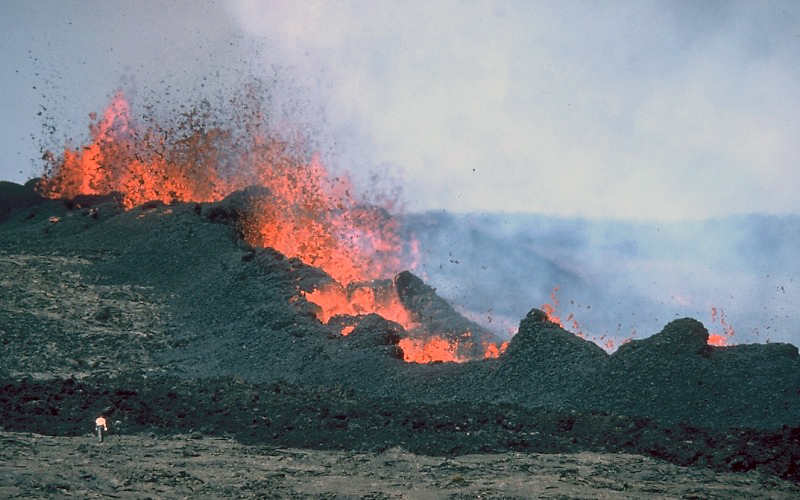

|
|
 |
Mauna Loa lava flows tend to be larger and move faster than at nearby Kilauea. HVO image from 1984, person for scale. (Edited and color balanced image from USGS HVO image library) |

|
Mauna Loa erupted from NE rift zone vents high on the volcano in the early AM of 6 July 1975; lava flowed toward Mauna Kea. (image from USGS HVO website) |
![]()
|
| |||||
| Tweets about Mauna Loa @kenhrubin | |||||
 |
Mauna Loa, or "Long Mountain" in Hawaiian, is located on the island of Hawaii. It is pictured above rising 13,680 ft. (4,170 m) above sea level (this photo was taken from over Loihi seamount, some 30 km or so to the south). Since 1832, Mauna Loa has erupted 39 times; its last eruption was in 1984. According to USGS estimates, the volcano has erupted an average of once every 6 years over the past 3000. The Hawaiian Volcano Observatory celebrated the 30th anniversary of Mauna Loa's last eruption (in 1984) on March 25, 2014, underscoring that it has been a realtively quite 3 decades at the world's largest active volcano. | ||||
 |
How active? Mauna Loa is one of Earth's most active volcanoes. Since 1843 it has erupted 33 times producting lavas that have covered over 800 km2. The image at right shows Mauna Loa lava flows since 1832 (warm colors) overlain on a 3-d digital elevation model. The view is looking towards the west, with Hilo qt the bottom center, Kilauea at left, and Kona coast on the north. Learn all about the hazards associated with this eruption history at the HVO website |
||||
| How Tall? Mauna Loa is a REALLY tall and big mountain. At 60 miles long and 30 miles wide, it makes up half of the entire island. When one considers that the flanks of Mauna Loa sit on sea floor that is about 16,400 ft (5,000 M) deep, the "height" of this volcano relative to neighboring land (the sea floor) is more like 30,080 ft (9,170 m)! Mauna Loa is the largest active volcano in the world. In fact, using this last measure of its height, it is one of the tallest mountain in the world (although many mountains, such as Mt. Everest in the Himalaya mountain range, sit higher relative to sea level). All large land masses (such as mountains) also push down upon the Earth's crust due to their enormous weight. So, directly beneath Mauna Loa, the sea floor on which it sits is depressed by and additional 26,000 ft (8000 m). Thus, if one wanted to say how thick (at its center) is the lava pile that makes up Mauna Loa, one would need to add its above sea level height, its sea floor to sea level height, and the thickness of its depression in the Pacific sea floor. These total 56,080 ft (17,170 m). For more details about estimation of the actual thickness of Mauna Loa volcano, see the write up on "How high is Mauna Loa volcano" at the HVO website. | |||||
|
Mauna Loa Awakening?
Get Mauna Loa activity updates from the HVO website |
|||||
 A peaceful Mauna Loa as viewed from the summit of Kilauea volcano in March of 1998 | |||||
| Mauna Loa is a "shield volcano", which means it is a gently sloping mountain produced from a large number of generally very fluid lava flows. The volcano has been erupting for at least 100,000 years (possibly more) from a primary volcanic center that is presently manifested by Moku'aweoweo crater at the mountain's summit. It has produced both a'a and pahoehoe flows, and lesser amounts of pyroclastic deposits. The volcano is constructed of a rock type known as tholeiitic basalt. Mauna Loa shares the Hawaiian hot spot with its smaller active siblings Kilauea and Loihi seamount. You can view a schematic representation of the geometry of this situation HERE. If you would like to learn more about how the Hawaiian islands formed from a single mantle hotspot, visit the Formation of the Hawaiian Islands web page at this site. | |||||
|
The earliest written account of a Mauna Loa eruption, based upon the observations of an elderly guide (Keaweehu) in the Wilkes exploration party to the summit in 1840-1841, says an eruption took place in 1780. This is shortly after Captain Cook's first visit to the islands. In 1868, and an eruption from Mauna Loa caused the largest recorded earthquake in Hawaii, a magnitude 8 by modern standards. The lava flow of 1855-1856 is said to be one of the greatest flows ever seen by modern observers. An eye witness account by the Rev. Titus Coan is available at this web site The oldest remnants of subaerial Mauna Loa are to be found in an interesting rock formation known as the "Ninole Volcanic Series". It is a series of steep-sided hills, consisting of thin layers of pahoehoe and a'a lava. These hills form the so-called "Ninole Shield" which is thought to be either the remnants of a pre-Mauna Loa volcano, or uplifted blocks of old Mauna Loa from within the Honuapo-kaoiki fault system. Either way, they are some of the oldest exposed rocks on the southern part of the island. | |||||
![]()

|

|

|

|
||
| HCV Home | Hawaiian Volcanoes | Loihi | Kilauea | Mauna Loa | Hualalai |
This page is maintained by Ken Rubin ©,
It was originally created in the late 1990s by Ken and Rochelle Minicola as part of the Kailua High School Community Quest work experience program, in cooperation with the Hawaii
Center for Volcanology.
Other credits for this web site.
Volcano Quick Links
General Reference
Hawaiian volcano info:Links




